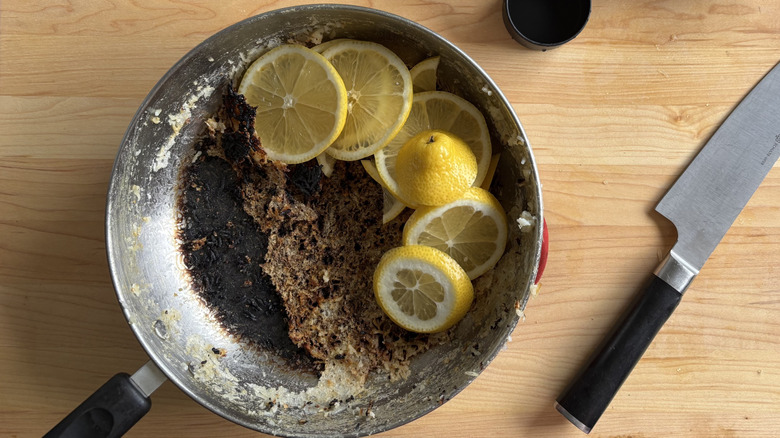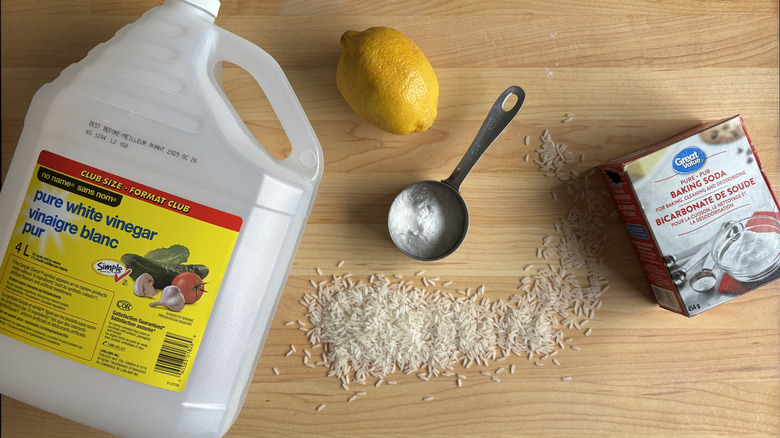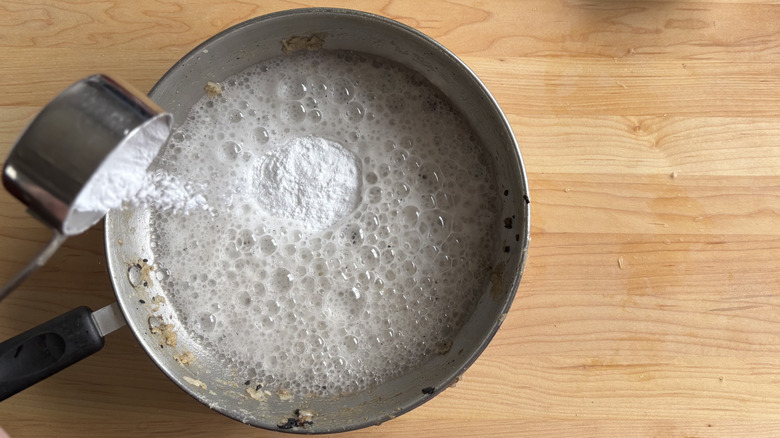We Tried Three Hacks To Remove Burnt Rice From A Pan, And One Out-Shone The Rest
We may receive a commission on purchases made from links.
Rice is one of nature's tastiest grains, but being so starchy, it is tricky to cook and even trickier to keep from burning the pan. This is when cleanup gets impossible. All that delicious starch, sugars from sauces and vegetables, and seasonings seem to fuse themselves to the bottom of the pan. I find this to be particularly awful with metal cookery. In my effort to minimize the task, I turned to the internet for help and got three suggestions: vinegar, lemon, and baking soda.
The hacks using vinegar and lemon involve acid, which can be a problem for some materials. Nonacidic cleaners are best for cast iron and stainless steel to avoid ruining your pans, and acidic methods work well for aluminum and copper. I decided to test all three to learn which one stuck ... or in this case, unstuck. Let's see if the secret ingredients that remove stubborn burnt-on rice really work, and which one works best.
Preparing for our rice cleaning experiment
Before testing cleanup on a pan, I decided to make a real mess (when else can you burn food onto a pot on purpose?). I used jasmine rice for this experiment, which I would normally rinse the excess starch from first, but not today! I went with an old stainless steel pan that I've had forever and didn't mind ruining. I recommend following the guidelines by your cookware manufacturer to keep yours in good shape, but for simplicity's sake, I'm using the same pan for all three methods. Burning the rice was easy. After setting off my smoke detectors, I saved as much of it as I could before letting it really blacken (I hate wasting food). Then I was ready to gather the cleaning supplies.
I chose Great Value baking soda and No Name vinegar to keep things affordable, but you can use whatever is in your pantry. If you don't have No Name brand where you live, Happy Belly is a good substitution. I also purchased two good-sized lemons. I sliced the citrus fruit, and measured out ¼ cup each of baking soda and vinegar. With any luck, this experiment will show me how to clean burnt pots and pans with ease using natural home ingredients, and I won't lose the cookware. Once everything was prepped, I was ready to get cleaning.
Tackling the burnt on mess
I started with lemons. The hack I followed suggested cutting two lemons into chunks, covering them in water, bringing to a boil, pouring it out, and scrubbing with a brush. I went with slices and started with just one (they're expensive!). Sheets of blackened starch floated to the surface as it boiled. Only a small amount of residue remained after scrubbing with a brush.
I prepped the pan again (RIP rice). To clean it this time, I mixed ¼ cup of vinegar with ¼ cup of water, and brought it to a boil. The liquid turned black and loosened the food. Again, there was some dark staining after scrubbing. It was time to try a little at-home chemistry with baking soda and vinegar.
The baking soda hack called for covering the cookware base with vinegar, bringing it to a boil, taking it off the heat, and mixing in 1 cup of baking soda. This seemed excessive to me, so I started with a ¼ cup. The reaction was visually impressive, but not as much rice floated up of its own accord and more scrubbing was needed. All three ingredients worked (mostly), but I had to finish each with my usual cleaning method of a sprinkling of baking soda and a pan scraper. I find nylon scrapers like those from Herda work well. Overall, the experiments were a success, but I don't know if I'd try them all again.
Preferences and takaways
There were no major issues with these experiments — apart from the smell of my house following the burnt-rice process. Each method worked for the most part, turning a could-be hassle of a job into a much easier one. Overall, I think the lemon and vinegar were the most impressive. Boiling the acidic mixture caused the stuck-on mess to lift away almost immediately. A scrub brush dislodged most of the mess without fuss, leaving only a small amount of a burn stain to manage. The baking soda mix was very reminiscent of the elementary science fair, but overall, it wasn't as productive in removing the rice. If I had to pick just one, I'd probably go with vinegar because it's cheap, simple, and has solid results.
The only thing I would note for future use of these pan-saving methods is that, unlike some online content might suggest, these are not magic fixes. A little elbow grease is needed to fight residual blackness. I imagine the success of these cleaners is also skewed by the level of starch in your rice and how burnt it is. Now, I'm interested to know what other unexpected kitchen ingredient you can use to clean burnt pans in a pinch. Hopefully, my experiments help you save time and effort in your own burnt-rice fiascos in the future. Just remember to check on which material your cookware is made of and whether it can handle acidic solutions before getting started.



